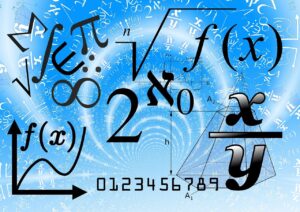Technical specialties are very popular now. Because of this, many parents wonder how to get kids interested in math. Journalist Jennifer Doverspike offers her answer. Here is an adapted translation of her article.
My young daughter sits at the kitchen table in front of a problem book, pencil clutched in her left hand, tongue slightly out from thinking about salutatorian meaning. She looks at me and says, “Mom, this is so cool!” And goes back to studying. Line by line. Task after task. 9+1=_. 7+1=_. She stops, squeaks with delight. Whispers ominously: “I’m about to do 13 + 1!”
I’ve read before about how we teach math in America. And I’ve seen memes poking fun at the Common Core program (the unified set of state educational standards in the United States – ed.). But I never thought to put my thoughts on the subject together until I saw my daughter happily and voluntarily solving problems from her Kumon textbook.
I watched her enthusiastically solve page after page and thought, “Sweetie, one day you’re going to hate it all.” That frightened me. Of course, she’s still a few years away from learning formal math in school. And who cares what curriculum they take or what teachers they get, as long as she likes math enough to look for extra problems. Obviously, she has a mathematical mind. Isn’t she?
A couple of years ago I wrote about the basics of literacy. One of the key tenets is that literacy learning isn’t just about memorizing words by sound and writing, although that’s important, too. Imaginative play has a role to play, because it increases situational vocabulary and teaches the child that stories have a beginning, middle, and end. The last thing I would wish for my daughter is for her love of reading and books to be beaten out of her with countless cramming and spelling tests.
At school, my daughter is also learning math in a playful way. Their teachers are inspired by the Reggio Emilia approach, for example, they teach addition by playing board games where you have to count how many squares forward to go. But I read article after article about education in the United States, and I begin to fear that in high school it will all come back to formulas and countless rows of problems in the textbook.
It hits me right where it hurts. I personally hate math including printable touch math numbers. I used to be good at it in high school, I even took math classes my freshman year. But there the techniques taught to me by the teacher were enough only to pass the exam and safely forget about everything the very next day. The subjects related to algebra in high school made me realize that I really did not understand mathematics. I could calculate the derivative or the integral, I knew all the basic definitions, but I just didn’t “see” mathematics the way my peers in the group did.
So, if my daughter wants to learn, I would like to teach her. To give her the basics of math just in case the program can’t handle it. I want her to remember that math is about problem solving and imagination and the endless promise of more. Not just numbers on paper. At her current level, I don’t want her to just remember that 5+3=8. I want her to know that 25+3=28 and 45+3=48, and why everything is so neatly and perfectly arranged in our decimal number system. So how do we do that?
1. Emphasize the beauty of math.
A musician wakes up from a creepy nightmare. In it, he finds himself in a society where music education is a must. “We help students become more competitive in a world filled with sounds. Teachers, schools, and the state are in charge of this vital project. Educational programs, commissions, decisions-all without the involvement of a single musician.
…Waking up in a cold sweat, the musician realizes that it was just a crazy dream. “Of course,” he mutters. – No society would reduce such beautiful, significant art to something so emasculated and banal. No culture could be so cruel to its children as to take away such a beautiful, joy-giving medium of expression. How ridiculous!” Across town, an artist woke up from a similar dream… (excerpted from Paul Lockhardt’s book, The Mathematician’s Lament).
When I think of math or https://argoprep.com/blog/word-family-finding-the-commonalities/, countless rules come to mind, labyrinthine constructs that have to be pulled from the dusty recesses of my brain to solve a problem in front of my eyes. Elementary math isn’t so bad. Even with numbers, symbols, and conventions, we can demonstrate patterns and dependencies. But then what happens in most schools, as Tara Holm writes in the Boston Globe, is a descent into mathematical Hades, a death march that goes to Calculus (mathematics in the American school curriculum).
Once Calculus begins, teachers are greatly tempted to march down this path. Avoid comprehensive explanations about how the decimal system works, big numbers or multiplication, or put it off far into the future. As Andy Kiersch writes in Business Insider, “formulas and algorithms are presented without context or motivation, students are forced to simply memorize and apply them…It’s all contrary to what the science of math is really about. Mathematics is one of man’s most creative, poetic enterprises. And the fact that it is taught in schools in this way is a disaster.”
Visual materials (like beads or acorns) are often used in elementary school, for example, to show addition visually. That’s how I taught my kids to take their first steps. But some programs, like the Montessori system, are a step ahead in this approach. This system uses self-correcting visual materials that introduce children to the basics of math long before symbols and equations. With the help of Montessori “golden beads,” children are taught the basics of the decimal system (this is an educational toy where the beads are assembled ten at a time in a segment – ed.).
While you’re a child, you probably can’t appreciate the beauty of abstraction as much as you can understand the abstract concepts of mathematics. But the Montessori system does the opposite. Visual learning toys themselves are beautiful and simple. Like math.
And we’re back to “The Mathematician’s Cry.” I may not remember much about quint circles, but if you put me at the piano, I’ll play.
2. Figure out the fundamentals.
When is Cheryl’s birthday? (a popular online logic problem – ed). When the task from high school went viral, users gave out conflicting answers, and some adults even struck panic or confusion. Given that its conditions are quite mysterious, many wondered how it was possible to basically come up with the right answer here?
I don’t think most adult Americans are capable of solving this problem. In fact, because this problem wasn’t written for 11-year-olds in Singaporean schools, as the Internet told us. It’s a problem from a high school math Olympiad. But it still baffles me that many adults didn’t even know how to begin to solve it.
There is a bit of a gulf between counting beads to learn addition and learning the symbols that represent addition. For my daughter, it was filled with the number row 1 2 3 4 5 6. If you asked her what goes through two divisions of 4, she would answer 6. Then, using the same numbers, I show her that 4+2=6. The schools in Singapore have this “demonstration” phase that fills this gap. Simple arithmetic equations are illustrated with simple graphs.
The same Montessori gold beads show key fundamental principles of multiplication in a simple and straightforward example. The Singapore method of teaching, like the golden beads, allows the student to eventually figure out how to model the answer to a complex problem like “Cheryl’s birthday,” without relying too much on memorizing formulas. In this kind of learning process, each new lesson builds on top of the previous one like LEGO pieces.
But the problem is that teachers and parents themselves are often confused about math, not to mention the “pictorial learning” methods of math. Giving a child a bad grade for writing 15=5+5+5 instead of 15=3+3+3+3+3 is the teacher’s problem, not the standards of the educational system.
Another problem with our educational system is the “spiral approach,” instead of the way Singaporean schools hone in on each math concept. More and more ideas are being thrown at students, jumping from topic to topic without going into details, promising to come back to the topic again next year… Many recommend programs where students are not required to immediately find the answer to a problem.
First you need to build a base for the solution, and then you need to find the most efficient way. Otherwise, the efficiency of learning would be comparable to, for example, sitting third graders down, breaking them into groups, and making them deconstruct the allegories of Orwell’s Animal Farm, making them memorize Martin Luther King’s speech the next day, and grading their knowledge by essays on Shakespearean comedies as a result.
3. Tell Stories
He told a story about Carl Friedrich Gauss, the famous German mathematician who was born in 1777. When Gauss was still a schoolboy, his teacher ordered him to add up all the numbers from 1 to 100. The task should have taken an hour, but Gauss found the answer almost instantly. “Does anyone know how he did it?” asked Juarez Correa (a famous Mexican educator – ed.).
Several students tried adding numbers and soon realized that it took a long time. Paloma, working with her group, carefully wrote down several sequences and then raised her hand: “The answer is 5050. That’s 50 pairs of 101.”
Juarez Correa felt a slight chill. He had never encountered a student with such innate ability. He sat down next to the student and asked why she had never been interested in math, since apparently she was good at math.
“Because no one ever made math interesting.” (story from Wired).
The best math programs emphasize “understanding concepts as a tool to predict, study and explain the world around us.” Richard Ruzhik, creator of the Art of Problem Solving school and its junior equivalent, Beast Academy, says it requires “creativity, gifting and vigorous mental gymnastics.” His program first presents students with problems and questions, and only after students have worked on them independently do they get the right solution algorithm.
“The Art of Problem Solving” is designed for gifted students, but a child doesn’t need to be gifted to enjoy the Kitchen Table Math textbook, an introduction to math for very young children. Growing up, they can also learn from the Life of Fred series of textbooks. Its creator, Stanley Schmidt believes children should learn by reading and immersing themselves in the story, self-learning along the way. Rather than forcing children to ponder “Where can we get all this stuff,” books like this show children that they already do math every day, they just don’t realize it.
